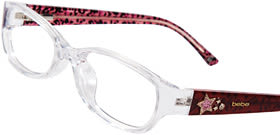Eyeglass frames for teens: 5 shopping tips

Shopping for eyeglass frames with your teen can be a lot of fun. But choosing frames can be overwhelming, too.
These five tips will make the process of finding great-looking glasses for teenagers much easier.
1. Choose frames that complement your face shape, features and coloring.
Choosing eyeglasses that complement your appearance begins with taking a close look at the shape of your face.
If your face is angular or square, round and oval frames look best. The opposite also is true: if your face is round or oval, you'll usually look best in square and angular frames to balance your facial features.
Also, if the top of your face is wider than the bottom (heart-shaped), select a frame with a dramatic (wider, heavier, etc.) bottom edge for balance. Conversely, if your face is wider on the bottom, choose a frame with a more prominent brow line.
The frame's bridge can influence the appearance of your eyes and nose. A thin or clear bridge gives the illusion of width to close-set eyes, while a colored one will make wide-set eyes appear closer together. Also, a low bridge will make your nose appear shorter.
The color of your eyeglass frames should complement your coloring, including skin tone (warm or cool), skin color (ranging from fair to dark) and hair color. A "warm" skin tone has a golden yellow tint; a "cool" skin tone has either blue or pink as its base color.

For a trendy look that doesn't hide your eyes, try a style with a clear front, such as this new frame by bebe optical.
Frame colors that are a good match with warm skin tones include brown, most metals, and splashy colors. Colors that complement cool tones include gray, silver and muted colors.
The color of your skin and the color of your hair influence the best frame choices as well. If you have light coloring (ivory skin and blond hair, for example), consider more subtle frame colors.
For medium coloring (olive skin and brown hair, for example), light-colored metals and brown frames tend to look the best. If you have dark coloring (chocolate skin and black hair, for example) most metallic frames will look good.
What if your coloring is kind of mixed, like fair skin and medium-brown hair? Try frames that match each coloring to see which suits you better.
Still not sure? Bring a friend along to help you decide.
2. Pick frames that are not too big, not too small.
If you choose a frame that is too large, visual distortion and glare can occur. If your frame is too small, you limit your peripheral vision.
Generally, the frames shouldn't be wider than the widest part of your face, with the exception of frames for oval faces, which can be a little wider.
When you put on a pair of glasses, your pupils should appear at (or very near) the center of the lenses.
The frames should feel secure on your face, but not so tight that they pinch your nose or leave red marks on your nose, the sides of your head, or behind your ears.
On the other hand, the frames should not be so loose that they slide down your nose.
The top of the frames should not be above your eyebrow line, and the bottom shouldn't touch your cheeks. And they should be feel secure and comfortable behind your ears.
3. Choose eyeglass frames that match your lifestyle.
You know what your style is: dressy, jeans and T-shirts, bohemian, whatever. Choose eyeglass frames that will complement your favorite appearance.
4. Don't let your lenses distract.
Reflections in your lenses can distract from the appearance of your glasses, interfere with your vision, and make it difficult for others to see your eyes. Whatever frames you choose, make sure your eyeglass lenses include anti-reflective coating for the best vision, comfort and appearance.
5. Weigh the value of frame materials and other features.
Generally, eyeglass frame materials can be classified as plastic, metal or a combination of both.
Metal frames
Metal frames — particularly those made of stainless steel or titanium — last longer than most plastic frames. So you might want to consider metal frames if you think you'll want to keep your glasses for a long time and just get new lenses as needed.
Because most metal frames have adjustable nose pads, they work well for people whose noses are too small or large for plastic frames.
If you are allergic to certain metals (nickel, for example), make sure you are aware of the exact composition of metal frames and choose one that's hypoallergenic.
Also, take into account the kind of jewelry you like to wear. If you wear a lot of gold, you might not want silver-colored frames, and vice versa.
Plastic frames
Plastic frames usually need less maintenance than metal ones, but certain types of plastic contract and expand with temperature changes and may require frequent adjustments.
Spring hinges
Do you tend to accidentally break things a lot? If so, you might want to look to consider flexible hinges, which are more durable than regular hinges. For example, you can bend the temples of the frame out more with spring hinges than you can with regular hinges.
Get started — with an eye exam
So, that's it: five simple steps to fantastic frames for teens. Now, schedule an eye exam with an eye doctor near you to update your eyeglass prescription — and start shopping!
Page published on Wednesday, February 27, 2019






